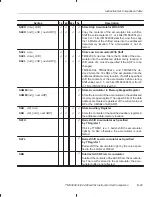
Instruction Set Comparison Table
B-23
TMS320C1x/C2x/C2xx/C5x Instruction Set Comparison
Syntax
Description
5x
2xx
2x
1x
MAC
pma, dma
MAC
pma, {ind} [, next ARP]
√
√
√
√
√
√
Multiply and Accumulate
Multiply a data-memory value by a program-memory
value and add the previous product (shifted as speci-
fied by the PM status bits) to the accumulator.
MACD
dma, pma
MACD
pma, {ind} [, next ARP]
√
√
√
√
√
√
Multiply and Accumulate With Data Move
Multiply a data-memory value by a program-memory
value and add the previous product (shifted as speci-
fied by the PM status bits) to the accumulator. If the
data-memory address is in on-chip RAM block B0, B1,
or B2, copy the contents of the address to the next
higher address.
MADD
dma
MADD {
ind} [, next ARP]
√
√
Multiply and Accumulate With Data Move and
Dynamic Addressing
Multiply a data-memory value by a program-memory
value and add the previous product (shifted as defined
by the PM status bits) into the accumulator. The pro-
gram-memory address is contained in the BMAR; this
allows for dynamic addressing of coefficient tables.
MADD functions the same as MADS, with the addition
of data move for on-chip RAM blocks.
MADS
dma
MADS {
ind} [, next ARP]
√
√
Multiply and Accumulate With Dynamic
Addressing
Multiply a data-memory value by a program-memory
value and add the previous product (shifted as defined
by the PM status bits) into the accumulator. The pro-
gram-memory address is contained in the BMAR; this
allows for dynamic addressing of coefficient tables.
MAR
dma
MAR {
ind} [, next ARP]
√
√
√
√
√
√
√
√
Modify Auxiliary Register
Modify the current AR or ARP as specified. MAR acts
as NOP in indirect addressing mode.
MPY
dma
MPY {
ind} [, next ARP]
MPY #
k
MPY #
lk
√
√
√
√
√
√
√
√
√
√
√
√
Multiply
TMS320C1x and TMS320C2x devices: Multiply the
contents of the T register by the contents of the ad-
dressed data-memory location; place the result in the
P register.
TMS320C2xx and TMS320C5x devices: Multiply the
contents of the T register (TMS320C2xx) or TREG0
(TMS320C5x) by the contents of the addressed data-
memory location or a 13-bit or 16-bit immediate value;
place the result in the P register.
















































